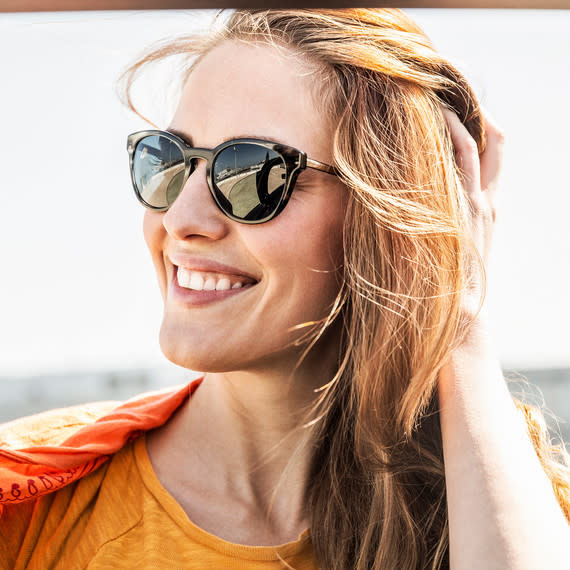Here's What You Need to Know About Buying Sunglasses

Shopping for sunglasses seems easy enough: pick out a frame that complements your face and then choose a lens that you love. Since most sunglasses are shaded or feature lenses with mirrored or polarized designs, you might assume they're all protective against the sun's harsh ultraviolet rays. But not all sunglasses are created equal when it comes to shielding your eyes, a misconception that eye care specialists say they encounter frequently. "This is an issue year round—even on cloudy days or during the winter time, we're constantly exposed to UV light, which can lead to different conditions," says Ashley McCain, O.D., a professor of ophthalmology at the University of Washington's School of Medicine and an eye-care expert at the Karalis Johnson Retina Center. "The back layer of the eye is similar to the skin, so people can actually get cancer from consistent exposure to the sun and harsh UV light. We put sunscreen on our skin, but sunglasses are really the 'sunscreen' for the eyes."
Wearing sunglasses that are made without UVA- and UVB filters (or no sunglasses at all) can eventually lead to poor eye health, including cataracts and a serious, incurable condition called macular degeneration. This eye disease affects more than 10 million Americans, and is the leading cause of vision loss in the country, according to the American Macular Degeneration Foundation. We asked McCain for her best advice on shopping for eyewear that will help protect your vision for years to come, and what to consider if you already wear prescription glasses.
RELATED: How to Protect Your Vision As You Age
How to Identify the Best Sunglasses
In most cases, you won't be able to tell a pair of vanity sunglasses from a pair that can properly shield your eyes just by looking at them. To understand a pair of shade's true protective quality, you'll need to inspect the labeling, keeping an eye out for certain language that indicates how the glasses were made. "The most important thing is that it's labeled with language that says it protects against UVA and UVB rays and that it can provide UV absorption from 400 nanometers, which is usually represented by a '400NM' label," McCain says. This can prove to be a challenge if you're buying a pair second hand at a flea market or online, so if you're spending significant time outside, McCain recommends shopping only at a knowledgable eyewear retailer, or with a certified healthcare professional.
Luckily, proper eye protection doesn't necessarily mean a higher price tag. "Price doesn't come into play here; a cheap pair of sunglasses can provide adequate protection on their own, as long as they're labeled accordingly and are made with UVA and UVB protective layers," McCain notes. If you're ever wondering if a particular pair of sunglasses is right for you, try looking for an endorsement from the Vision Council, the accredited committee that oversees a national standard, according to McCain. "The ANSI Z80.3 is an American national standard that provides guidelines for recreational sunglasses...the only way to likely ensure that consumers are purchasing an ANSI-accredited pair of sunglasses would be to purchase them from a reputable optical shop."
RELATED: 12 Ways to Stay Cool During a Hot Summer
When to Choose a Transition Lens
You may be surprised to learn that darker lens colors do not provide superior defense against the sun's rays. "Lens color itself has no effect—any pair of sunglasses, in any tint or color, will be better at protecting your eyes compared to dark shades if they bear the '400NM' label," McCain says. "Even clear lenses can have proper coatings on there to block UV rays." If you're already wearing prescription lenses, there could be UV protective layers applied to the exterior of your glasses depending on the manufacturer, but you may be better off wearing Transitions lenses, as they can aid your vision while also providing greater relief from the sunlight's effect on your eyes.
"If someone is wearing prescription lenses and they're made of polycarbonate lenses, it should have some form of UV protection already on the lens—if you're working inside most of the day, those may be sufficient," she says. "But if you are spending more time outside, transitions are much more convenient than having to constantly swap out your prescription lenses with sunglasses." For those who drive frequently, windshields are typically designed with a UV-blocking layer to aid drivers and prevent squinting and glare. But McCain also recommends "XtraActive" Transitions lenses, which can mitigate reflective surfaces better and provide you the corrective vision that sunglasses can't. You can add these lenses to frames of your choice at an eyewear retailer that carries them.
The Best Frames to Choose
There are many different frames to choose from, and while style preferences are important, McCain says the best options are those that cover the most skin around your eyes. Sunglasses that feature metal, wire frames, and small, circular lenses may be less effective at blocking UV rays than sport-enhanced styles. "The lens may be able to repel UV rays, but does it actually shade your eyes? The larger the frame, the more coverage you have. Ideally, they should wrap around the side of your face, and provide peripheral coverage as well," she says.
When spending extended periods of time outside—either working in the garden or lounging on the beach—McCain says it's best practice to wear more than just sunglasses for preserving eye health. Wear a large, brimmed hat, and consider bringing an umbrella with you; you'll be doing your skin a favor as well.
